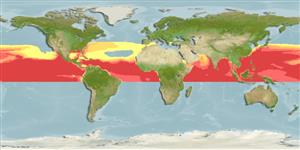Common names from other countries
Environment: milieu / climate zone / depth range / distribution range
بوم شناسي
دريايي; اقیانوس رو (Ref. 51243); تغييرات عمق 0 - ? m. Tropical; 42°N - 36°S, 180°W - 180°E (Ref. 93339)
Circumglobal: all oceans preferably open ocean waters.
Atlantic: northward from 37°N in the western part of the ocean to 25° N in the eastern part and southward from 30° S in the western part to 8° S in the eastern part; somewhat broader in the Eastern Atlantic. It is quite rare in the Caribbean (except for the eastern part) and in the Gulf of Mexico.
Indian Ocean: Arabian Sea and Bay of Bengal in the north to the southern end of Africa and the western coast of Australia in the south; not found in the Red Sea, Aden, Oman and the Persian Gulfs, as well as in the easternmost part of the Indian Ocean in the waters between the southern Indonesian islands and the northern coast of Australia. Juveniles are distributed throughout the range of the species except in the most southwestern areas from the Mozambique Channel to the False Bay and in the waters off the west coast of Australia; juveniles were found in all seasons.
Pacific Ocean: northward from the northwestern tip of the Honshu Island in the west to 20° N in the east, and southward from the east coast of Australia to the waters of Ecuador and
Peru. Absent in the East China, Yellow and Japan Seas, quite rare in the South China Sea, none in the inner Indonesian seas.
Size / Weight / سن
Maturity: Lm ? range ? - ? cm
Max length : 25.1 cm SL جنس نر / بدون خواص جنسي; (Ref. 93339)
خارهاي باله پشتي (کل) : 0; شعاع نرم باله پشتي (کل) : 10 - 12; خارهاي باله مخرجي: 0; شعاع نرم باله مخرجي: 11 - 13. Body dark, iridescent blue above, silvery white below; dorsal and caudal fins greyish, other fins hyaline (Ref. 2797). Juveniles elongate, paired fins mottled (Ref. 2797).
Found in oceanic surface waters (Ref. 9839). Caught in surface waters over the depths 80-10,400 meters, usually 2000 to 6000 m (mean 4423 m) (Ref. 93339). Spawns throughout the year in warm waters (Ref. 6523).
Life cycle and mating behavior
Maturities | تولید مثل | Spawnings | Egg(s) | Fecundities | توزاد ( لارو)
Shakhovskoy, I.B. and N.V. Parin, 2013. A review of flying fishes of the subgenus Hirundichthys (genus Hirundichthys, Exocoetidae). 1. Oceanic species: H. speculiger, H. indicus sp. nova. J. Ichthyol. 53(2):117-145. (Ref. 93339)
وضعيت در فهرست قرمز IUCN (Ref. 130435)
CITES (Ref. 128078)
Not Evaluated
خطر برای انسان ها
Harmless
استفاده انسانی
ماهي گيري – شيلات: ارزش تحاري اندك
ابزارها
گزارش های ويژه
بارگيری XML
منابع اينترنتي
Estimates based on models
Preferred temperature (Ref.
115969): 1.2 - 2.9, mean 1.5 (based on 26666 cells).
Phylogenetic diversity index (Ref.
82804): PD
50 = 0.5002 [Uniqueness, from 0.5 = low to 2.0 = high].
Bayesian length-weight: a=0.00646 (0.00292 - 0.01429), b=3.04 (2.84 - 3.24), in cm Total Length, based on LWR estimates for this (Sub)family-body shape (Ref.
93245).
Trophic level (Ref.
69278): 3.0 ±0.08 se; based on food items.
جهندگی (Ref.
120179): زياد, كمينه زمان لازم براي دو برابر شدن جمعيت ، كمتر از 15 ماه (Preliminary K or Fecundity.).
Fishing Vulnerability (Ref.
59153): Low vulnerability (21 of 100).
